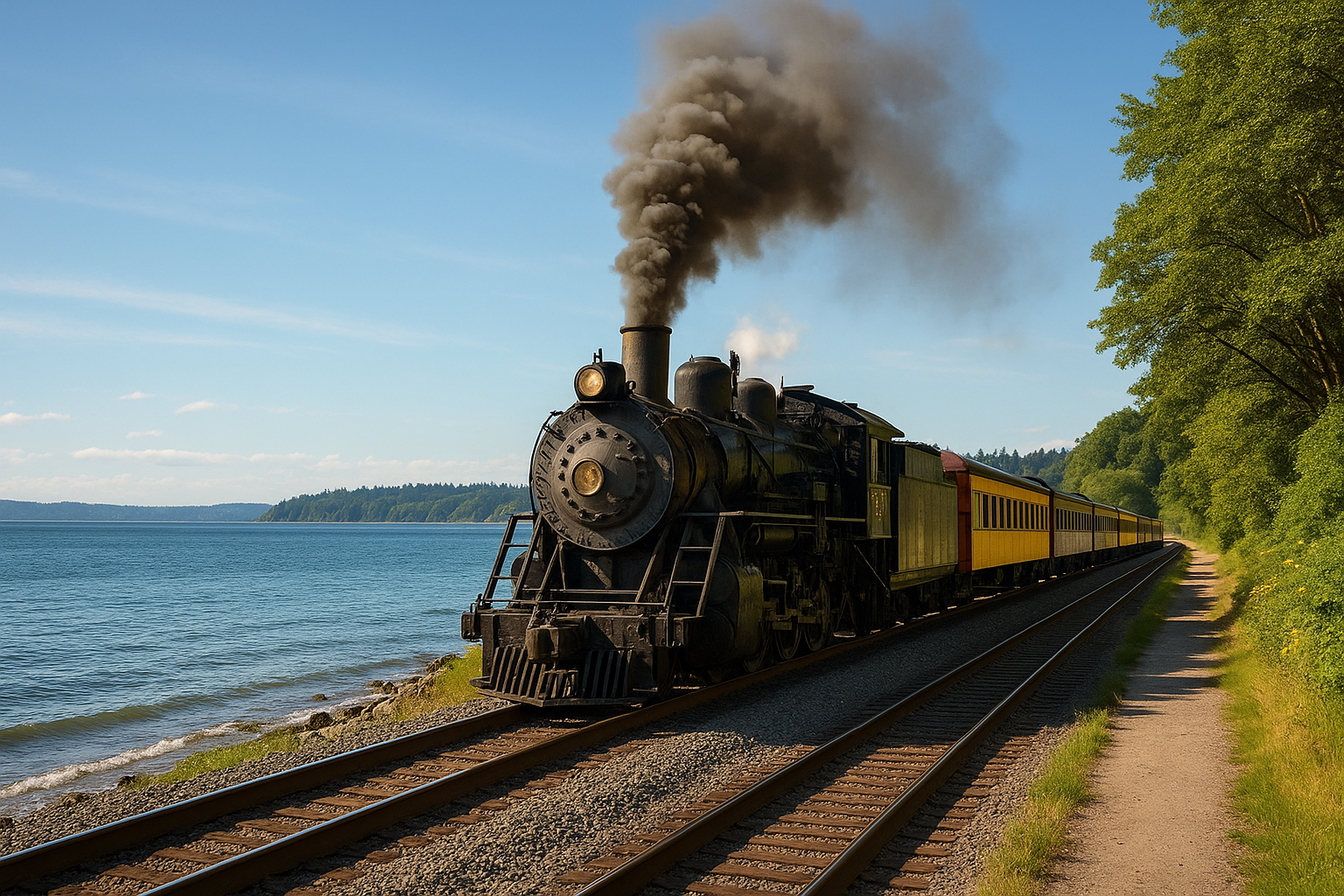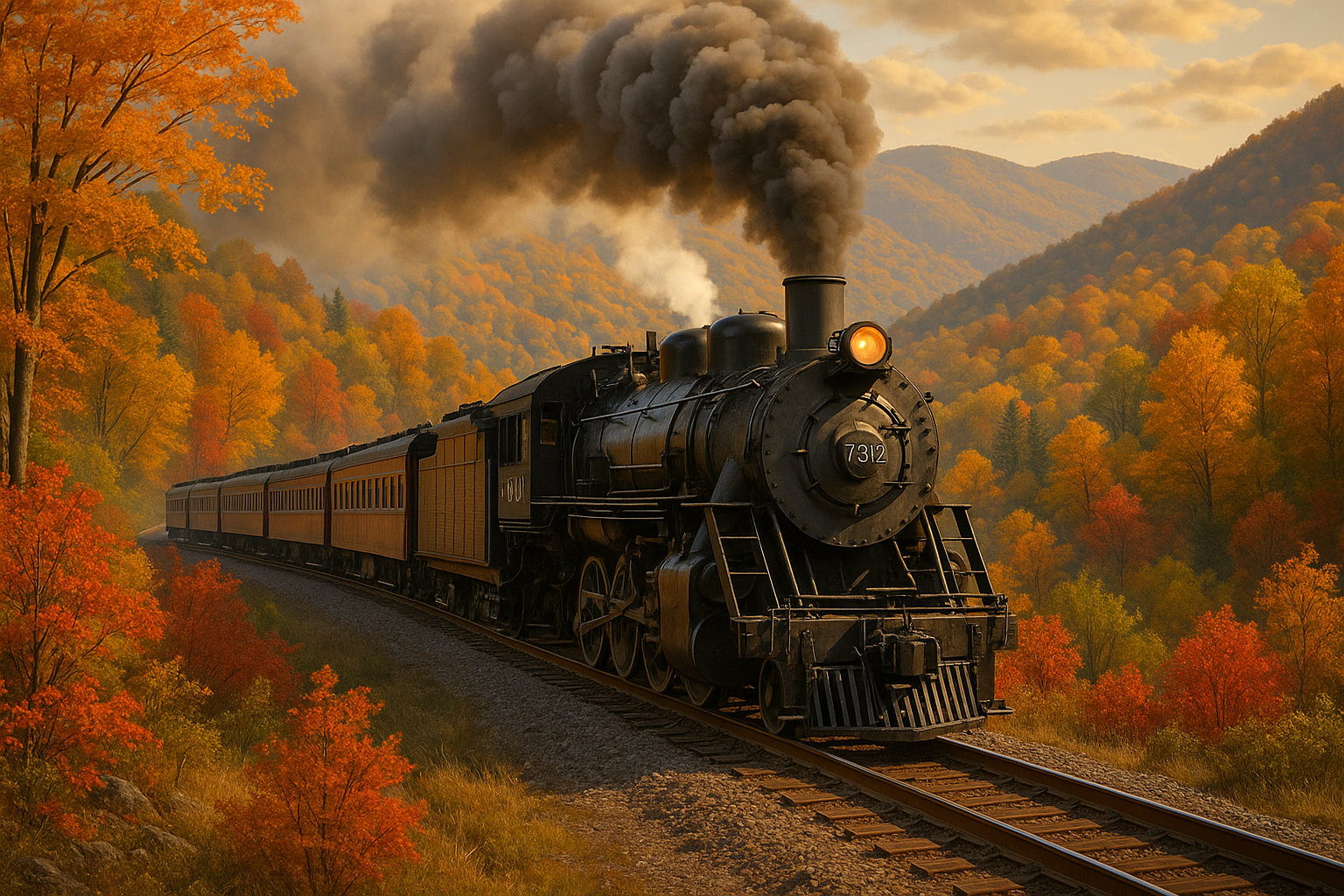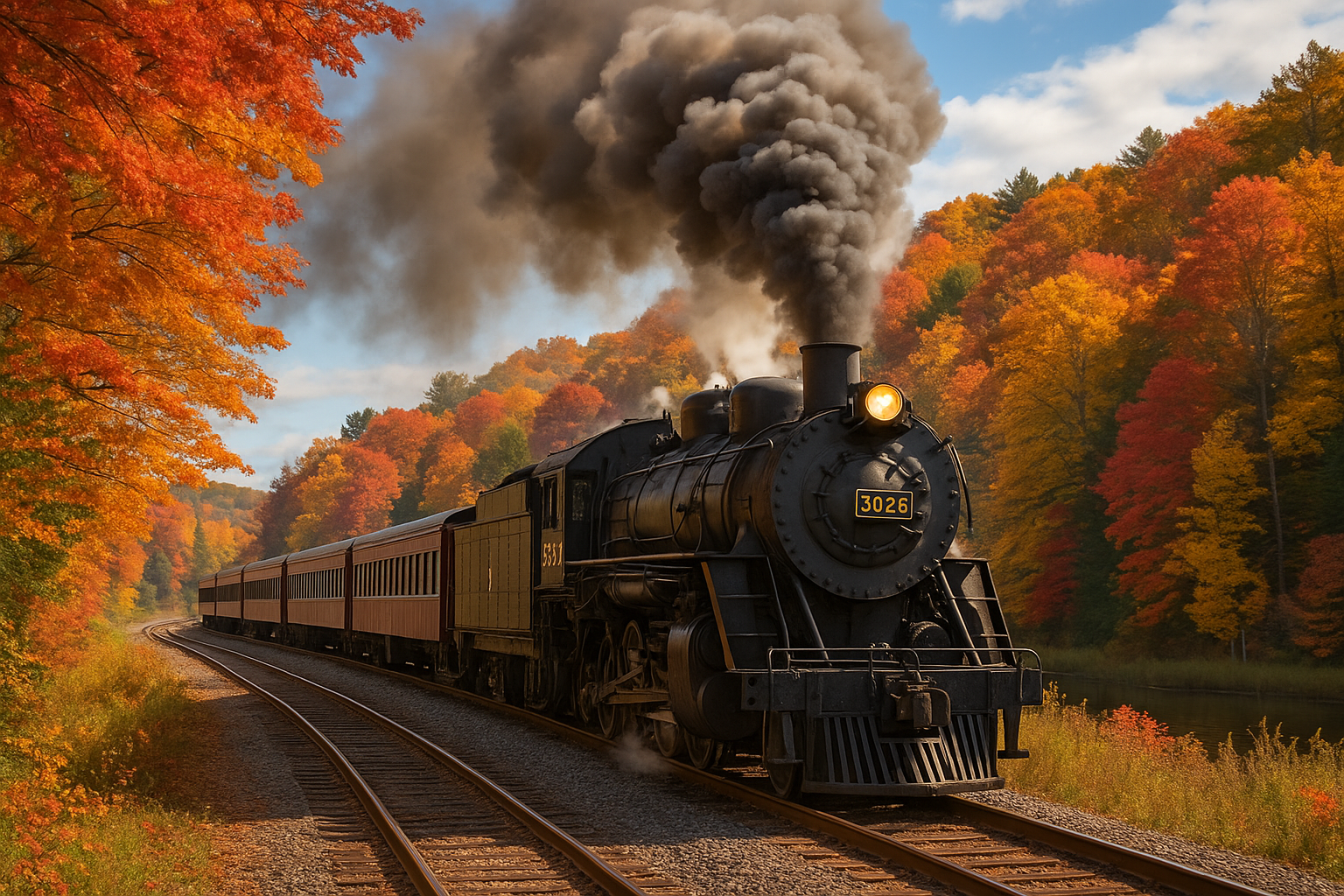GE "AC6000CW" Locomotives: Data, Specs, Roster
Last revised: January 1, 2025
By: Adam Burns
The AC6000CW was the most powerful, single-engine locomotive General Electric marketed in its storied history manufacturing diesel-electrics.
The model was released during the great horsepower race of the 1990s and built in conjunction with German manufacturer Deutz MWM.
The locomotive was equipped with a hybrid of GE's successful FDL prime mover while the company even built a "convertible" variant for Union Pacific that featured the standard 7FDL16 engine.
At the time UP was too anxious to wait for the 7HDL-powered AC6000CW and had GE construct several "convertible" types that could later be upgraded with the new prime mover.
Ultimately, the model saw few buyers for a multitude of reasons. But, GE wasn't alone; Electro-Motive also witnessed poor sales for its 6,000-horsepower variant, the SD90MAC.
Both Class I's would later overhaul their respective fleets; Union Pacific reclassified theirs as C44CM's while CSX rebuilt its AC6000CW's with GEVO prime movers. They were capable of producing nearly the same horsepower (5,800) and cataloged as CW46AH's.
Photos
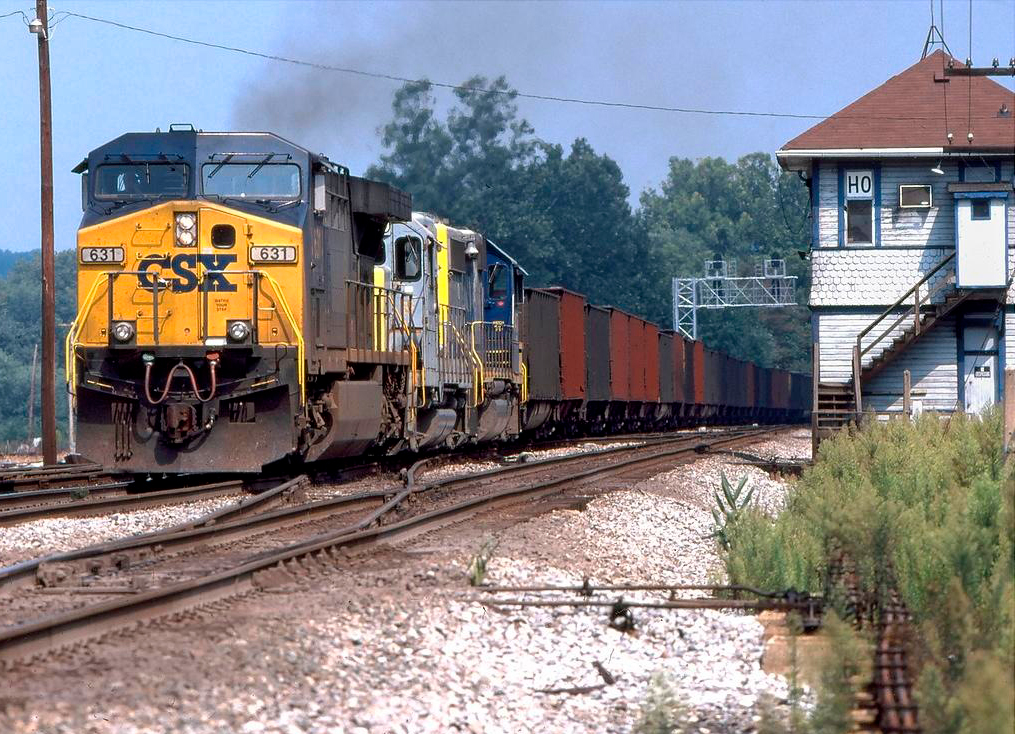 CSX AC6000CW #631 and two other units power train E113 past the B&O's old HO Tower at Hancock, West Virginia on August 25, 2000. Wade Massie photo.
CSX AC6000CW #631 and two other units power train E113 past the B&O's old HO Tower at Hancock, West Virginia on August 25, 2000. Wade Massie photo.Overview
The AC6000CW was developed during the mid-1990s. At this time the builder was enjoying a sales blitzkrieg, selling thousands of the DC-traction C44-9W and AC-traction AC4400CW. Both models offered 4,400 horsepower.
The AC6000CW was specifically intended as a more powerful variant of the AC4400CW, which saw nearly 3,000 examples roll out of Erie by the time production had ended domestically in 2004.
As Brian Solomon notes in his book, "GE Locomotives," the 1990s witnessed a renewed horsepower race that originally began in the 1960s when Union Pacific asked the then three major builders to construct experimentals in an attempt to reduce operating costs.
This time, the reasoning was more practical as both GE and EMD sensed a step up in power for standard main line locomotives was imminent.
The belief was that aging variants like the C30-7 and SD40-2, both 3,000 horsepower models, would not only need replaced by 1990s but could also eliminate an additional unit by placing a single 6,000 horsepower monster at the head-end.
In addition, GE had been well aware for decades that its FDL prime mover, based from the Copper-Bessemer design, could not produce greater than 4,000 horsepower.
By the 1990s this limit had been met with the slightly more powerful C44-9W and AC4400CW. In an effort to achieve greater horsepower from a single power plant GE teamed up with renowned engine manufacturer Deutz-Motoren Werke Mannheim (MWM) of Germany.
Their efforts produced the 7HDL engine. It was similar to its predecessor in many ways by carrying a V design, operated at 1,050 RPM, and was a four-cycle power plant.
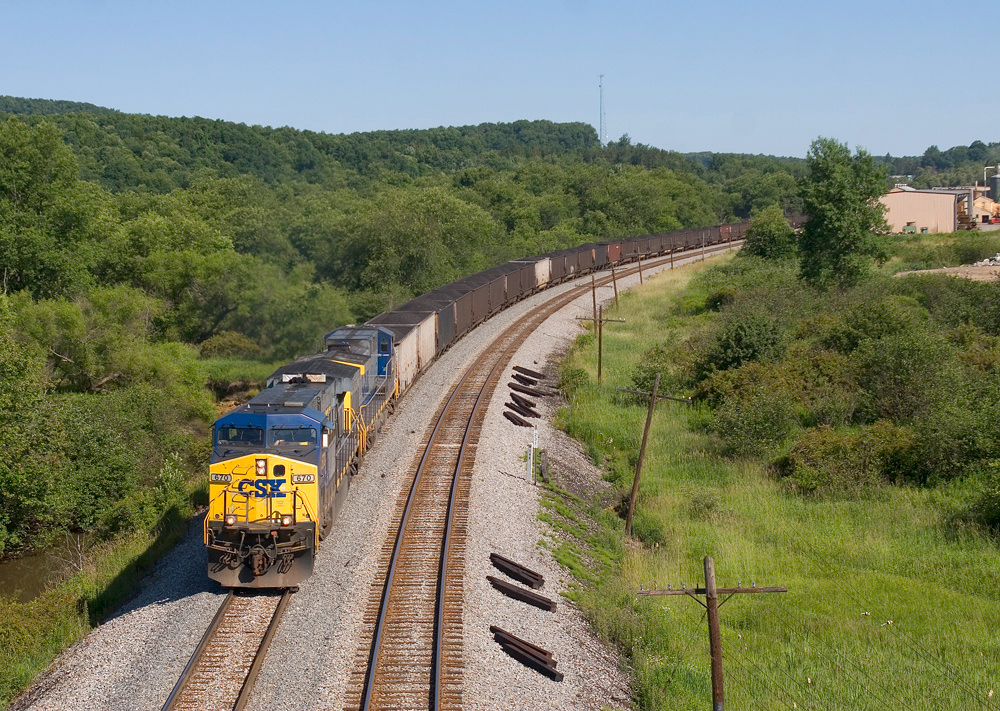 A pair of CSX AC6000CW's work coal drag U822 eastbound near Oakland, Maryland as the train is about to duck under the Rt. 219 overpass on July 2, 2007. Wade Massie photo.
A pair of CSX AC6000CW's work coal drag U822 eastbound near Oakland, Maryland as the train is about to duck under the Rt. 219 overpass on July 2, 2007. Wade Massie photo.In December, 1995 the first AC6000CW's rolled out of Erie and included three units acquired by CSX, #600-602. Union Pacific was so interested it couldn't wait for testing to be completed on the new engine.
Instead, it had GE manufacture a whopping 106 units between August, 1995 and April, 1998 of what became known as "Convertible" AC6000CW's.
While GE made no distinction between these models (powered by standard 7FDL prime movers rate at 4,400 horsepower) and 7HDL-equipped locomotives, they have become known as "Convertibles" as the units were intended to be refitted with the new engines once available.
Union Pacific classified these as C6044AC's. Interestingly, the units ultimately never received the upgraded prime mover and remained 4,400-horsepower locomotives.
Both inwardly and outwardly the AC6000CW was virtually identical to its predecessors except for the updated prime mover. Its most noticeable external features included:
- Overall length (76 feet).
- An additional small step along the right side of the outside walkway which accommodated air reservoirs that had to be placed higher on the frame to make way for a larger fuel tank.
- An oversized rear radiator that extended beyond the hood.
The model was also one of the first to be equipped with the relatively new high-adhesion (or HiAd) truck, which helped improve wheel-to-rail contact.
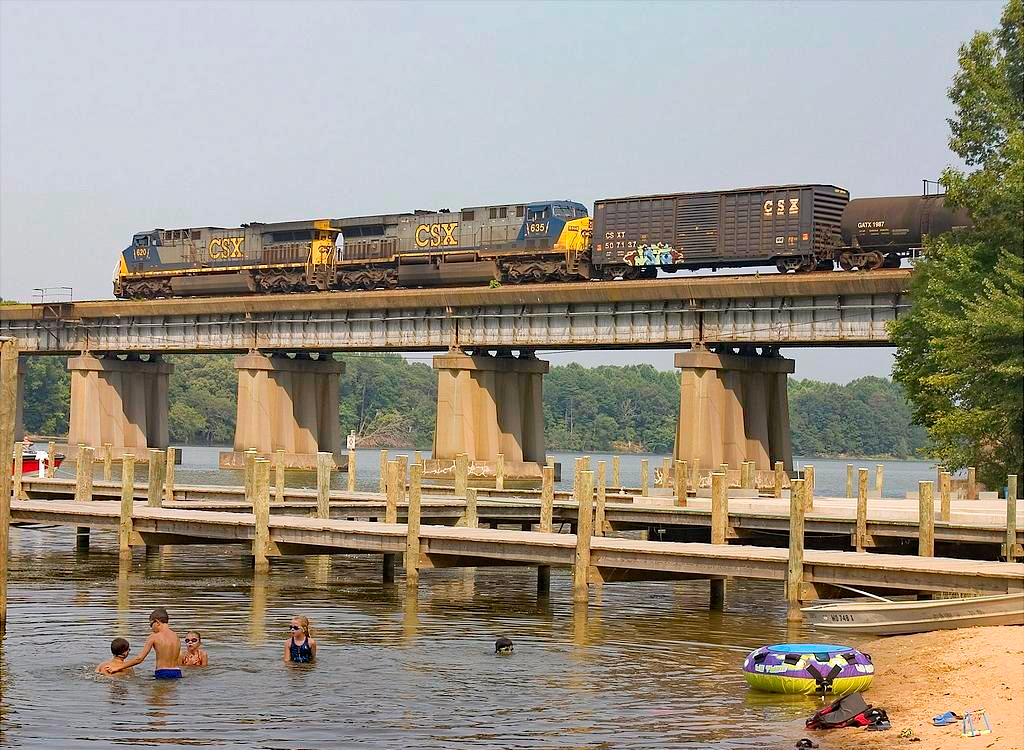 Kids are enjoying the cool waters on a hot summer day as CSX AC6000CW #620 passes overhead leading freight Q406 across Aquia Creek Bridge near Aquia, Virginia on August 4, 2005. Wade Massie photo.
Kids are enjoying the cool waters on a hot summer day as CSX AC6000CW #620 passes overhead leading freight Q406 across Aquia Creek Bridge near Aquia, Virginia on August 4, 2005. Wade Massie photo.The AC6000CW's model designation carried GE's standard practice for that era:
- "AC" referred to the model being alternating current,
- "6000" of course referred to its horsepower rating, the
- "C" referred to the unit having a C-C truck setup (three axles per truck)
- "W" designation meant it was equipped with the wide, safety cab
From an operational standpoint it provided the highest tractive effort of any main line locomotive up to that time, even more than the AC4400CW; 188,000 pounds starting and 166,000 using six of GE's model GEB13.
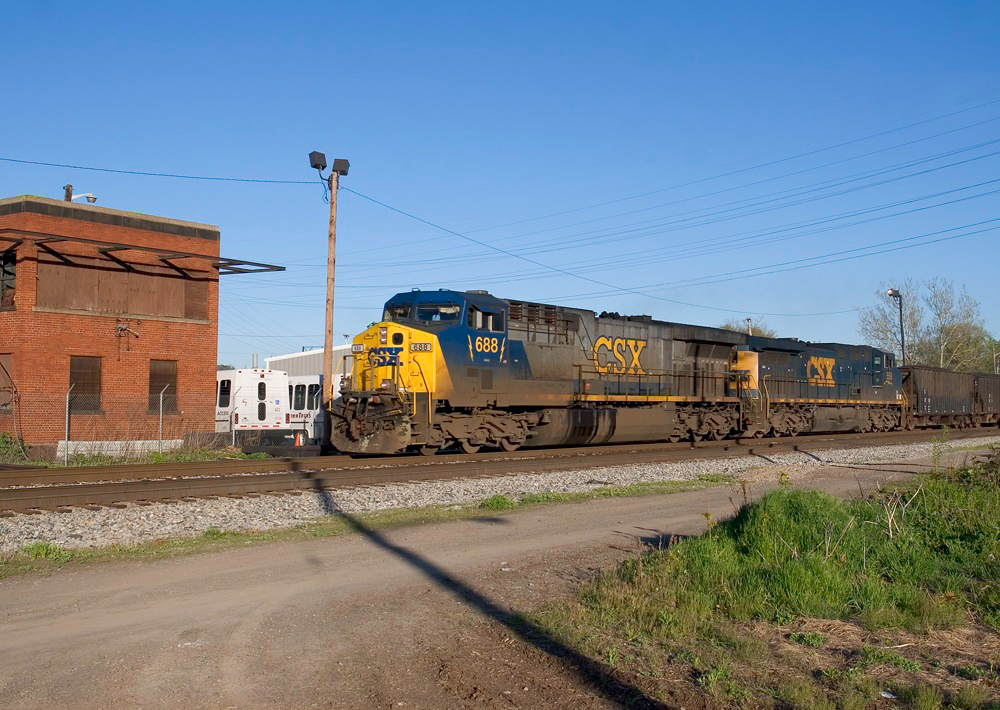 CSX AC6000CW #688 leads coal drag V969 past the former tower at McKees Rocks, Pennsylvania along the former Pittsburgh & Lake Erie on May 6, 2007. Wade Massie photo.
CSX AC6000CW #688 leads coal drag V969 past the former tower at McKees Rocks, Pennsylvania along the former Pittsburgh & Lake Erie on May 6, 2007. Wade Massie photo.Unfortunately, the AC6000CW ran into reliability issues, most notably with its engine; the engine block was too small and vibrations became a major issue, which resulted in other components failing or having problems.
Because of this GE did not begin full production until 1998; by that point railroads were shying away from a 6,000-horsepower locomotive for a number of reasons:
- Firstly, of course, was the reliability issue.
- Secondly, operational savings and the practicality of using a single power plant to pull an entire train.
While the idea was sound on paper, if this unit had mechanical issues and went down, the entire train would be stranded until relief could arrive.
Data Sheet and Specifications
AC6000CW
| Entered Production | 11/1995 (Union Pacific #7000) |
| Years Produced | 11/1995 - 12/2000 |
| GE Class | AC6000CW |
| Engine | 7HDL16A (16 cylinder) |
| Engine Builder | General Electric/Deutz MWM |
| Horsepower | 6000 |
| RPM | 1050 |
| Length | 76' 0" |
| Height (Top Of Rail To Top Of Cab) | 15' 5" |
| Width | 9' 11" |
| Weight | 425,000 Lbs |
| Fuel Capacity | 5,500 Gallons |
| Air Compressor | 3CDC (Westinghouse) |
| Air Brake Schedule | 26L (Westinghouse) |
| Trucks | C-C |
| Truck Type | Hi-Ad Bolsterless |
| Truck Wheelbase | 13' 2" |
| Wheel Size | 42" |
| Traction Motors | GEB13 (6), GE |
| Traction Alternator | GMG201, GE |
| Auxiliary Alternator | GYA30A, GE |
| MU (Multiple-Unit) | Yes |
| Dynamic Brakes | Yes |
| Gear Ratio | 83:20 |
| Tractive Effort/Starting | 188,000 Lbs |
| Tractive Effort/Continuous | 166,000 Lbs at 13.7 mph |
| Top Speed | 75 mph |
AC6000CW (Convertible)
| Entered Production | 11/1995 (Union Pacific #7013) |
| Years Produced | 8/1995 - 4/1998 |
| GE Class | AC6000CW |
| Engine | 7FDL16 (16 cylinder) |
| Engine Builder | General Electric |
| Horsepower | 4400 |
| RPM | 1050 |
| Length | 76' 0" |
| Height (Top Of Rail To Top Of Cab) | 15' 5" |
| Width | 9' 11" |
| Weight | 412,000 Lbs |
| Fuel Capacity | 5,500 Gallons |
| Air Compressor | 3CDC (Westinghouse) |
| Air Brake Schedule | 26L (Westinghouse) |
| Trucks | C-C |
| Truck Type | Hi-Ad Bolsterless |
| Truck Wheelbase | 13' 2" |
| Wheel Size | 42" |
| Traction Motors | GEB13 (6), GE |
| Traction Alternator | GMG201, GE |
| Auxiliary Alternator | GYA30A, GE |
| MU (Multiple-Unit) | Yes |
| Dynamic Brakes | Yes |
| Gear Ratio | 83:20 |
| Tractive Effort/Starting | 188,000 Lbs |
| Tractive Effort/Continuous | 166,000 Lbs at 13.7 mph |
| Top Speed | 75 mph |
Production Rosters
AC6000CW
(Total Built = 212)
| Owner | Road Number | Serial Number | Order Number | Completion Date | Quantity |
|---|---|---|---|---|---|
| CSX Transportation | 600-602 | 48975-48977 | 1860 | 12/1995 | 3 |
| General Electric (Demo/Test) | 6000 | 48879 | 1852 | 12/1995 | 1 |
| Union Pacific | 7000-7004 | 48880-48884 | 1863 | 11/1995-12/1995 | 5 |
| Union Pacific | 7005-7009 | 48885-48889 | 1863 | 12/1996 | 5 |
| Southern Pacific | (600-602) | (49062-49064) | (Order Canceled) | (Order Canceled) | (3) |
| Union Pacific | 7005-7009 | 48885-48889 | 1863 | 12/1996 | 5 |
| Union Pacific | 7510-7554 | 50944-50988 | 1873 | 7/1998-12/1998 | 45 |
| BHP Iron Ore (Australia) | 6070-6077 | 51062-51069 | 1886 | 11/1998-2/1999 | 8 |
| CSX Transportation | 603-636 | 51270-51303 | 1878 | 12/1995 | 34 |
| CSX Transportation | 637-699 | 51304-51366 | 1901 | 2/1999-12/1999 | 63 |
| CSX Transportation | 5000-5016 | 51367-51383 | 1901 | 2/2000-4/2000 | 17 |
| Union Pacific | 7555-7579 | 52459-52483 | 1921 | 11/2000-12/2000 | 25 |
| Union Pacific | 7511 (2nd) | 52484 | 1921 | 12/2000 | 1 |
AC6000CW (Convertible)
(Total Built = 106)
| Owner | Road Number | Serial Number | Order Number | Completion Date | Quantity |
|---|---|---|---|---|---|
| Union Pacific | 7013-7047 | 48890-48924 | 1864 | 8/1995-12/1995 | 35 |
| Union Pacific | 7010-7012 | 49285-49287 | 1867 | 8/1996 | 3 |
| Union Pacific | 7048-7079 | 49288-49319 | 1867 | 8/1996-9/1996 | 32 |
| Union Pacific | 7300-7335 | 50908-50943 | 1887 | 3/1998-4/1998 | 36 |
Sources
- Foster, Gerald. A Field Guide To Trains. New York: Houghton Mifflin, 1996.
- McDonnell, Greg. Locomotives: The Modern Diesel & Electric Reference, 2nd Edition. Buffalo: Boston Mills Press/Firefly Books, 2015.
- Solomon, Brian. American Diesel Locomotive, The. Osceola: MBI Publishing, 2000.
- Solomon, Brian. GE and EMD Locomotives: The Illustrated History. Minneapolis: Voyageur Press, 2014.
- Solomon, Brian. GE Locomotives: 110 Years Of General Electric Motive Power. St. Paul: MBI Publishing, 2003.
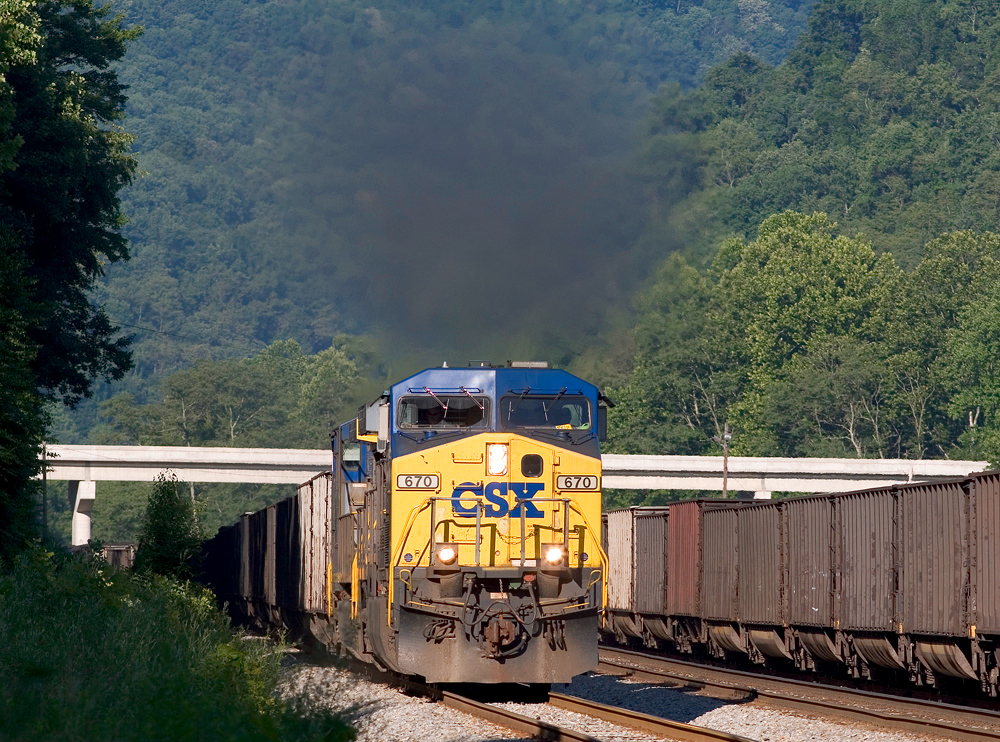 CSX AC6000CW #670 begins the hard, arduous climb up the former B&O's Cranberry Grade with eastbound coal drag U822 departing the yard in Rowlesburg, West Virginia on July 2, 2007. Wade Massie photo.
CSX AC6000CW #670 begins the hard, arduous climb up the former B&O's Cranberry Grade with eastbound coal drag U822 departing the yard in Rowlesburg, West Virginia on July 2, 2007. Wade Massie photo.By contrast, having two 4,400 horsepower units (or more) hauling a train this issue was resolved. It was simply a matter of flexibility coupled with operational efficiency.
In addition were other cost factors; two 6,000 horsepower locomotives, in some cases, would be too much power for a train and a waste of resources.
In the end, while most of the reliability issues were corrected, just a little over 300 AC6000CW's were built for CSX and Union Pacific by late 2000.
Contents
Recent Articles
-
Washington's Whiskey Train Rides
Jul 10, 25 03:06 PM
Climb aboard the Mt. Rainier Scenic Railroad for a whiskey tasting adventure by train! -
Maryland's Whiskey Train Rides
Jul 10, 25 01:05 PM
You can enjoy whiskey tasting by train at just one location in Maryland, the popular Western Maryland Scenic Railroad based in Cumberland. -
Connecticut's Whiskey Train Rides
Jul 10, 25 11:03 AM
In this article, we'll take a closer look at these special train rides, explore the magic behind them, and offer tips for anyone looking to embark on this memorable journey.
